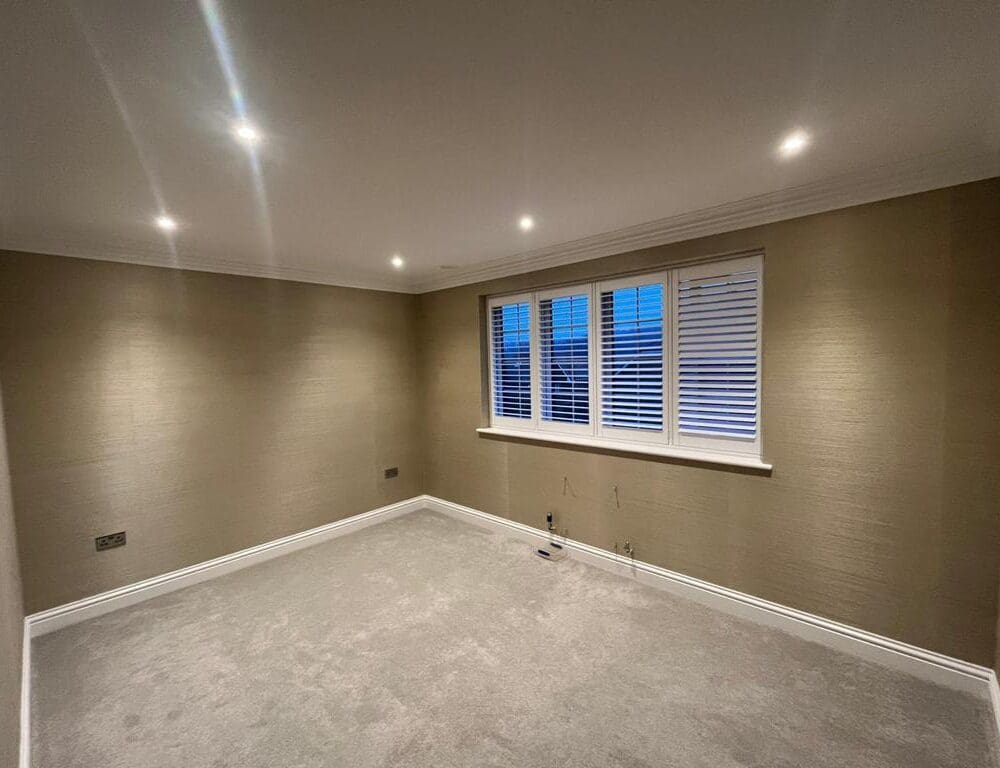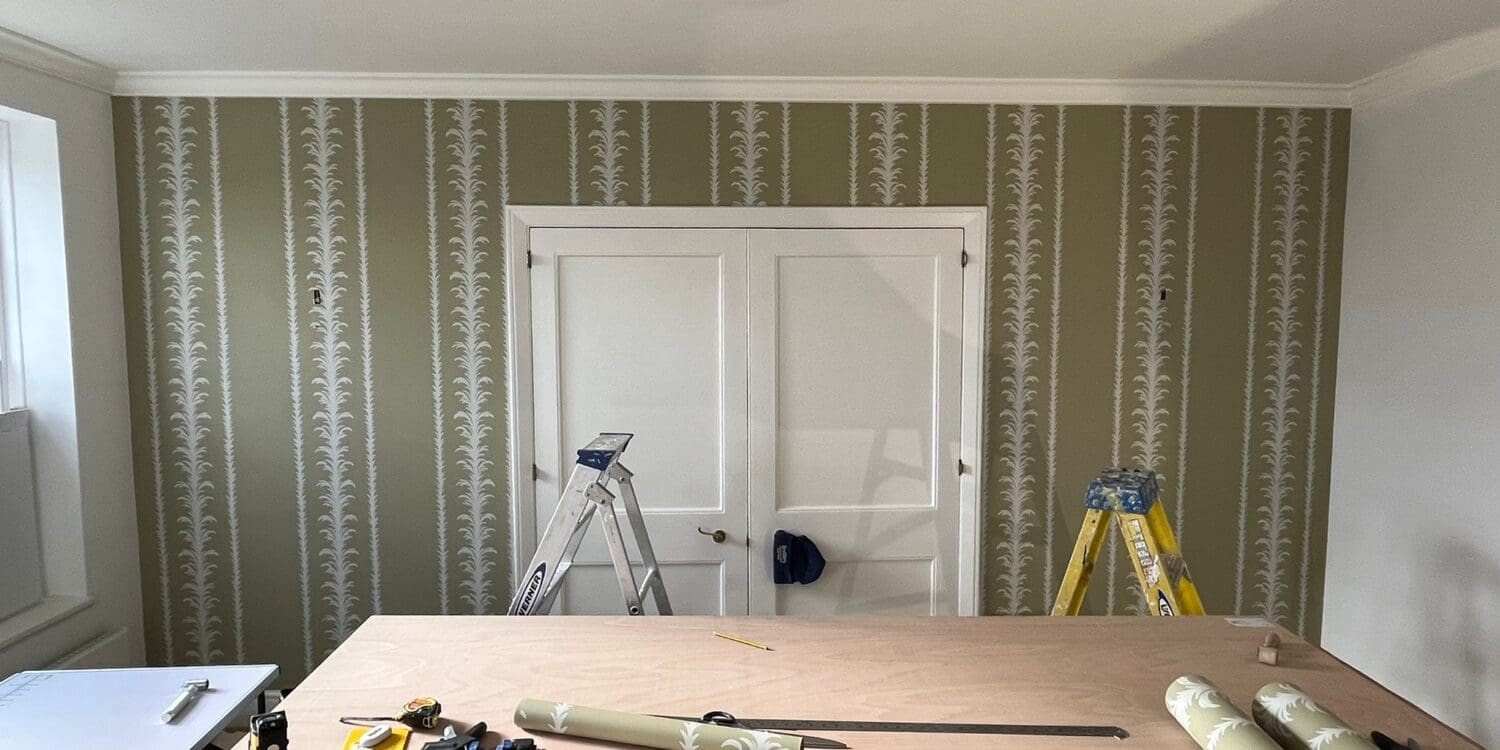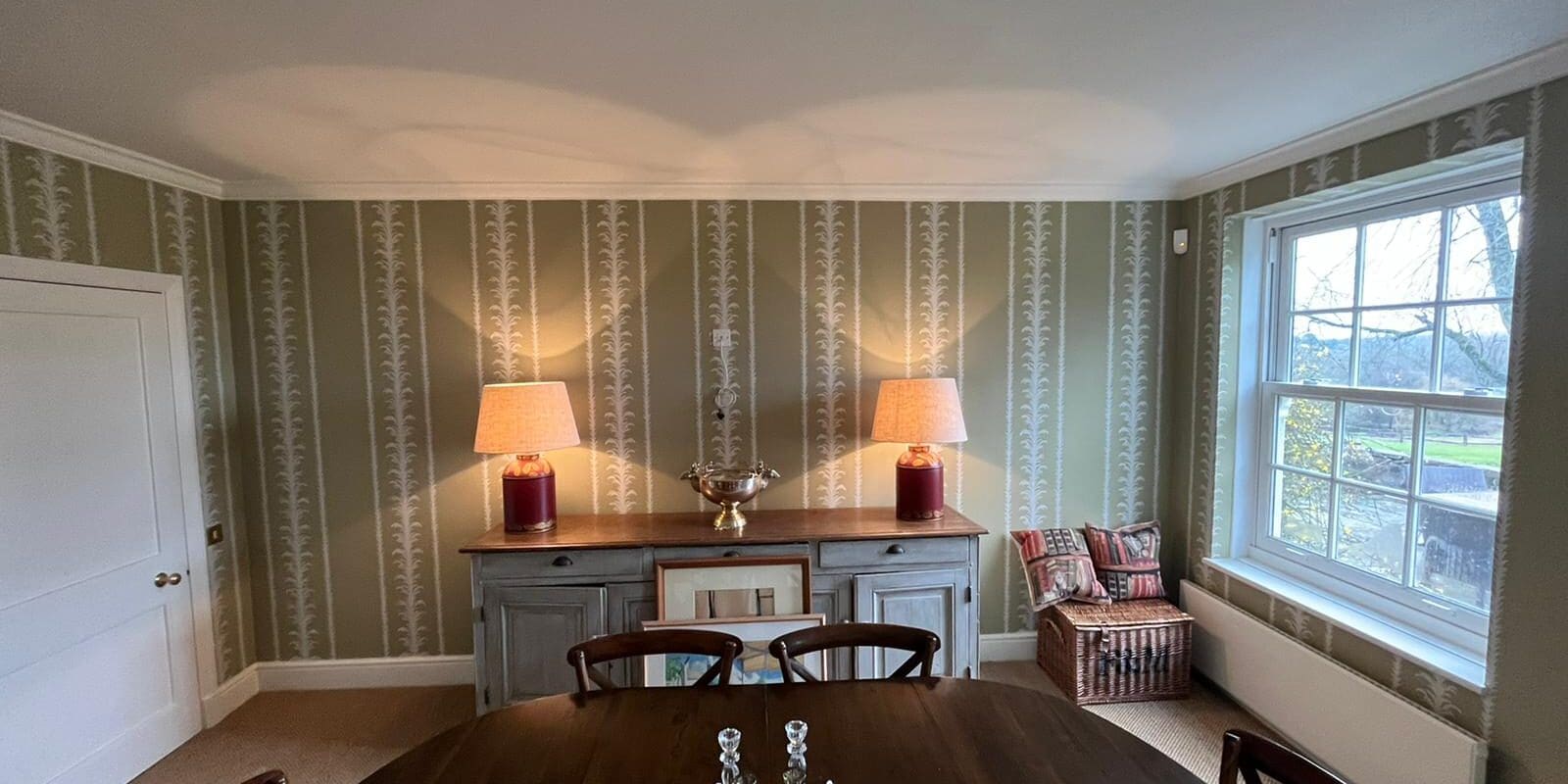Wallpapering a room can add character and bring new life to a space, but navigating around awkward spaces such as windows may feel like a daunting task. However, with the right tools, preparation and precision it needn’t put you off. Read on for our step-by-step guide on how to wallpaper around a window for a professional-looking finish.
Tools and Equipment You’ll Need Before You Start Wallpapering
Before we explain how to wallpaper around windows, it’s important you have the following tools and equipment to make the job as easy and manageable as possible.
- Your chosen wallpaper
- Wallpaper paste or adhesive
- Wallpaper brush or roller and tray
- Seam roller
- Utility knife
- Wallpaper smoothing tool or squeegee
- Measuring tape
- Sandpaper
- Filler
- Spirit level
- Pencil
- Bucket
- Damp sponge or cloth for cleanup

Step 1: Preparation for Wallpapering
Whether you are using paint or wallpaper on your walls, preparation is key. This is crucial to achieving a professional finish, especially around tricky areas like windows. Begin by cleaning the wall surfaces to remove any dust, grease, or dirt. If the wall has old wallpaper, strip it off completely to create a smooth surface for the new wallpaper. Use filler for any wall imperfections, and sand down rough patches for an even base. Prime the walls to improve the adhesive bond.
Once the wall is clean and smooth, measure out your wallpaper strips. Make sure each strip is slightly longer than required to allow room for adjustments and trimming. Pre-cutting wallpaper strips for the areas around windows and doors makes the process easier and prevents handling large, unwieldy sheets when you’re working in smaller, awkward spaces.
Step 2: Wallpaper the Window Recess
Start wallpapering within the window recess before tackling the areas around it. Cut a piece of wallpaper that will fit within the window reveal, with about 1-2 inches of excess. Apply paste to this piece of wallpaper and place it into the window recess, using a smoothing tool to remove any bubbles.
Using a utility knife, carefully trim the excess wallpaper to the edge of the recess. Repeat this process along each side of the window reveal, ensuring each piece fits snugly into the space. If you are hanging patterned wallpaper, align each section precisely to maintain a consistent look.
Step 3: Hang Wallpaper Above the Window
With the window recess completed, you’re ready to hang wallpaper above the window. Measure the distance between the top of the window and the ceiling and cut a strip of wallpaper slightly longer than this height.
When aligning the wallpaper above the window, start from the top of the ceiling and work your way down. Carefully align the top of the strip with the edge of the ceiling, pressing it in place and smoothing downwards. If there’s any excess hanging over the top of the window, use your utility knife to trim it. If you are using cottagecore wallpaper or wallpaper that has a pattern, take your time to lining up the patterns as this strip is one of the most visible.
Step 4: Use Off-Cuts to Fill the Gaps
Once you have wallpapered above the window, you may notice small gaps along the sides of the window frame. These can be easily filled with off-cuts of wallpaper. Measure the distance from the edge of the wallpaper to the corner of the window and cut an off-cut strip to size.
Apply paste to the strip, place it in the gap, and use a seam roller to ensure a clean, secure fit. Trim any overhanging wallpaper with a utility knife for a neat finish. If the wallpaper pattern is visible in these off-cut areas, be sure to match it carefully with the main section for a seamless look.

Step 5: Wrap the Wallpaper Around the Window Frame
For a clean, professional finish, wrap the wallpaper around the edges of the window frame. This requires precision to avoid wrinkles and bubbles. Start by measuring and cutting a piece of wallpaper that can wrap around the edge of the frame and extend slightly into the wall beyond it.
Apply paste to the back of the wallpaper and press it into place along the edge of the frame, using a smoothing tool to eliminate bubbles. Carefully fold the wallpaper around the edge, then smooth it onto the wall surface. Trim any excess with a utility knife.
Step 6: Wallpaper Under the Window
Now the rest of the window area has been wallpapered, it’s time to apply wallpaper to the wall section beneath the window. Measure this area and cut a piece of wallpaper that fits, ensuring an extra inch on each side for adjustments.
Align the wallpaper strip with the bottom edge of the window, pressing it onto the wall and smoothing out any air bubbles. Use a utility knife to trim the bottom and side edges. Check for any gaps or overlaps, especially around the window frame, and make final adjustments as necessary.
Step 7: Assess and Clean Up
Once the wallpaper is hung, step back and assess your work, paying close attention to the edges. Check for any air bubbles, creases, or loose edges, and use your smoothing tool to gently press these areas down, applying extra adhesive where needed to ensure a secure fit.
With the wallpaper properly smoothed and aligned, it’s time to clean up. Wipe away any excess adhesive from the wallpaper surface with a damp sponge or cloth, as leftover paste can dry and leave visible marks. Clean your tools thoroughly and dispose of any used wallpaper scraps. With your space clean and refreshed, your wallpapered room is now complete!
Read our blog on maintaining and cleaning wallpaper for further tips on how to keep your wallpaper looking fresh for years to come.
Summary
Hanging wallpaper around windows can be a challenge but by following these steps, you’ll be able to achieve a clean, seamless look. Preparation, patience, precision and having the correct tools and equipment will be key to the success of your wallpapering project.
At Marshals, we’ve proudly been delivering our painting and decorating services for over 35 years, completing 1000s of domestic refurbishment projects in this time. If you’d prefer some assistance with your wallpapering project, we’d be happy to hear from you. Check out our wallpaper hanging services or contact us today to arrange for a free no-obligation quote.
FAQs
How to wallpaper around a corner?
To wallpaper around a corner, measure and cut the wallpaper strip with about an inch of extra width to overlap onto the adjacent wall. Apply adhesive, then press the wallpaper smoothly around the corner, using a smoothing tool to remove air bubbles. Trim the excess with a utility knife, ensuring it aligns well with the next strip, to create a clean, continuous look.
How to wallpaper around a plug socket?
Before wallpapering, turn off the power and remove the socket or switch cover for safety and ease. Place the wallpaper over the socket area, gently smoothing it down, and then trim carefully around the socket with a utility knife, leaving a small margin to tuck behind the cover when it’s reattached. This extra margin ensures a neat, seamless look when you replace the cover.
How to wallpaper around a radiator?
Wallpapering around a radiator can be tricky but is manageable with careful measurements. Cut the wallpaper to fit around the radiator brackets, allowing for a snug fit. Using a smoothing tool, press the wallpaper down behind the radiator as much as possible, then trim with a utility knife to create clean edges. Using this method, you can still achieve a professional look without needing to remove the radiator.
Can you put wallpaper around a fireplace?
Yes you can and wallpapering around a fireplace can be a great way of enhancing the focal point of a room. Measure carefully, cutting strips to fit precisely around the edges for a neat, framed effect. If the fireplace is functional and used regularly, choose a heat-resistant wallpaper to prevent peeling or discoloration over time, ensuring both safety and durability.
How to hang wallpaper around a light fixture?
Turn off the power and remove the light fixture cover to create a smooth surface. Place the wallpaper over the area where the fixture is, smoothing it gently, then use a utility knife to trim neatly around the base. Once the wallpaper is in place, replace the fixture cover for a clean, professional look that integrates seamlessly with the wallpaper.








